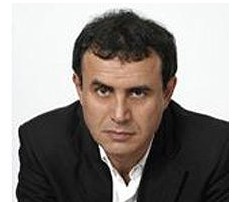
Earlier this month, Houses and Holes posted a report from Professor Nouriel Roubini warning that the Chinese economy is overheating and risks a sharp slowdown sometime after 2013.
Now Professor Roubini has followed up with an article on Project Syndicate fleshing-out his views in greater detail. Professor Roubini more or less supports earlier warnings from Michael Pettis and prominent China bears: Jim Chanos, Vitaliy Katenelson, Gary Shilling, Puru Saxeena and Andy Xie.
Below are the key extracts from Professor Roubini’s Project Syndicate article.
China’s economy is overheating now, but, over time, its current overinvestment will prove deflationary both domestically and globally. Once increasing fixed investment becomes impossible – most likely after 2013 – China is poised for a sharp slowdown…
China has grown for the last few decades on the back of export-led industrialization and a weak currency, which have resulted in high corporate and household savings rates and reliance on net exports and fixed investment (infrastructure, real estate, and industrial capacity for import-competing and export sectors). When net exports collapsed in 2008-2009 from 11% of GDP to 5%, China’s leader reacted by further increasing the fixed-investment share of GDP from 42% to 47%.
Thus, China did not suffer a severe recession – as occurred in Japan, Germany, and elsewhere in emerging Asia in 2009 – only because fixed investment exploded. And the fixed-investment share of GDP has increased further in 2010-2011, to almost 50%.
The problem, of course, is that no country can be productive enough to reinvest 50% of GDP in new capital stock without eventually facing immense overcapacity and a staggering non-performing loan problem. China is rife with overinvestment in physical capital, infrastructure, and property. To a visitor, this is evident in sleek but empty airports and bullet trains (which will reduce the need for the 45 planned airports), highways to nowhere, thousands of colossal new central and provincial government buildings, ghost towns, and brand-new aluminum smelters kept closed to prevent global prices from plunging…
Eventually, most likely after 2013, China will suffer a hard landing. All historical episodes of excessive investment – including East Asia in the 1990’s – have ended with a financial crisis and/or a long period of slow growth. To avoid this fate, China needs to save less, reduce fixed investment, cut net exports as a share of GDP, and boost the share of consumption…
Several Chinese policies have led to a massive transfer of income from politically weak households to politically powerful companies. A weak currency reduces household purchasing power by making imports expensive, thereby protecting import-competing SOEs and boosting exporters’ profits.
Low interest rates on deposits and low lending rates for firms and developers mean that the household sector’s massive savings receive negative rates of return, while the real cost of borrowing for SOEs is also negative. This creates a powerful incentive to overinvest and implies enormous redistribution from households to SOEs, most of which would be losing money if they had to borrow at market-equilibrium interest rates…
To ease the constraints on household income, China needs more rapid exchange-rate appreciation, liberalization of interest rates, and a much sharper increase in wage growth…
Continuing down the investment-led growth path will exacerbate the visible glut of capacity in manufacturing, real estate, and infrastructure, and thus will intensify the coming economic slowdown once further fixed-investment growth becomes impossible. Until the change of political leadership in 2012-2013, China’s policymakers may be able to maintain high growth rates, but at a very high foreseeable cost.
Cheers Leith

